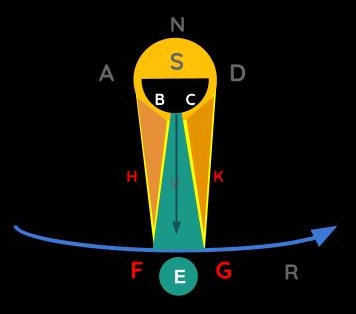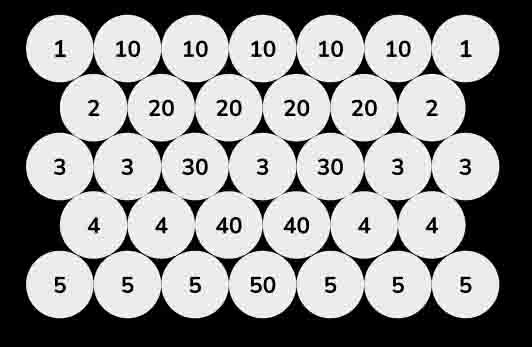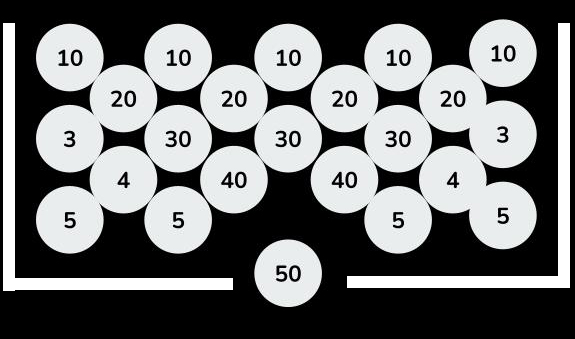Supermassive Black Holes as Galactic Vortices
Table of Contents
How can the air-aether between the lines AF and DG go all together towards E when the distance between A and D is greater than that between F and G?
- This makes them enter a narrower space than where they came from.

This is because their motion going out of the the center S does not affect the air-aether on their sides.
- It only affects those that are in front of them [those farther from
S]. - Those in front then affect those in their front, and so on.
When they move away from the center, they do not touch their neighbors that are at the same distance from that center.
- They only touch those that are a bit more distant from that center.
An example is the balls below.

The weight of the small ball:
1does not make it exert a force of102does not make it exert a force of20.3does not make it exert a force of30.4does not make it exert a force of40.
Instead, they only force:
- ball
1to rest on2 - ball
10to rest on20 - and so on.
Thus, these small balls can be arranged in many other ways.
The air-aether moves separately from one another. They can never be arranged like the balls above.
Galaxy Arms and Accretion Disks
Nonetheless, it is only in that mode [of arrangement] that the proposed difficulty manifests itself.

Their inclination to move away from S causes those between the lines AF and DG to advance all together towards E when E is void.
Thus, the weight of the small balls 40, 30, etc. causes them to fall all together toward the space 50 as soon as 50 can leave it.

This makes them enter a narrower space and consequently to move closer to one another.
The two 40 balls fall a bit faster, and move proportionately a bit closer to one another, than the three 30 balls.
- These three must move faster and closer to one another than the four
20balls, and so on.
The two 40 balls might come to touch one another after having fallen slightly. This makes them stop falling.
In the very same way, the air-aether that advances toward E will stop before filling that whole space.
- But they cannot advance toward
Ethe slightest bit since the whole space is already filled by some body (whatever it might be). - And so they press continually on that body and make an effort against it as if to chase it out of its place.[59]

Their other motions continue in them while they thus advance towards E. These:
- change their arrangement, and
- impede them from touching one another.
- Rather, it causes them, upon touching, to immediately to separate again.
Thus, they continue to advance uninterruptedly towards the space E, until it is completely filled.
The conclusion is that the force that causes them to go towards E is vibratory in nature.
- As the particles change position, it increases or relaxes those diverse small vibrations.
- This is a property suited to light.
The Gravitational Pull of a Star or Galaxy Comes From the Differences in the Air-Aethers
We have assumed that the spaces E and S and all the small angles between the air-aether are empty.
Now, fill them with the fire-aether.

The fire-aether in space E cannot stop the air-aether between the lines AF and DG from advancing to fill E up.
- This is because that fire-aether is already extremely subtle and agitated.
- They are always ready to leave the places where they are in.
This is why the fire-aether at E gives up its place to the air-aether at E going to S.
- That smaller air-aether goes to
Sto replace the larger air-aether that go out ofS.
The smaller air-aether go from E toward S between the larger air-aether that go from S towards E without impeding each other.
This similar to how the physical air in the sandclock XYZ rises from Z towards X through the sand Y while that sand falls towards Z.

The fire-aether in the space ABCD:
- composes the body of the sun
- there turns very rapidly in a circle around
S
These tend to move away from it in all directions in a straight line.
- All those in line
SDtogether push the air-aether particles at pointD - All those in line
SApush that which is at pointA, and so on.
This alone can cause all the air-aether between the lines AF and DG to advance towards the space E, even though they might have no inclination themselves to do so.
They thus must advance towards space E when it is occupied only by the fire-aether.
- They also tend to go there even though it is filled by some other body.
Consequently, they push and make an effort against that body as if to drive it out of its place.
Thus, if a man’s eye were at the point E, then it would actually be pushed, both:
- by the sun and
- by all the air-aether between the lines
AFandDG.
Such aethereal men would see light when their eyes are pushed in this way, just as we do.